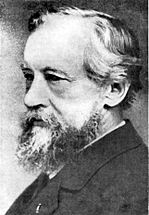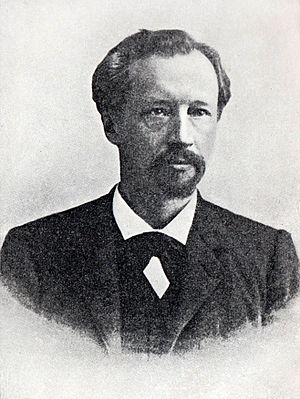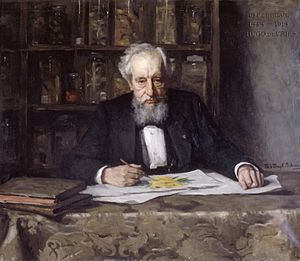Hugo de Vries facts for kids
Quick facts for kids
Hugo de Vries
|
|
|---|---|

de Vries, c. 1907
|
|
| Born |
Hugo Marie de Vries
16 February 1848 Haarlem, Netherlands
|
| Died | 21 May 1935 (aged 87) Lunteren, Netherlands
|
| Scientific career | |
| Fields | Botany |
| Institutions | Leiden University |
Hugo Marie de Vries (born February 16, 1848 – died May 21, 1935) was a famous Dutch botanist (a scientist who studies plants). He was also one of the first geneticists, meaning he studied how traits are passed down from parents to their children.
De Vries is best known for a few big ideas. He suggested the idea of "genes," which are like tiny instruction manuals inside living things. He also rediscovered the rules of how traits are inherited in the 1890s. He didn't know that Gregor Mendel had already figured this out years before! De Vries also came up with the word "mutation," and he developed a theory about how evolution happens through these sudden changes.
Contents
Early life and education
Hugo de Vries was born in 1848 in Haarlem, Netherlands. He was the oldest son of Gerrit de Vries, who was a lawyer and later became the Prime Minister of the Netherlands. His mother was Maria Everardina Reuvens.
From a young age, Hugo loved plants. He won many awards for his herbariums (collections of dried plants) while he was in school.
In 1866, he started studying botany at Leiden University. He really enjoyed learning about plants and was very interested in Charles Darwin's ideas about evolution, even though his own professor wasn't sure about them. Hugo wrote his final paper on how heat affects plant roots and finished his studies in 1870.
Early career as a plant scientist
After teaching for a short time, de Vries went to study chemistry and physics in Germany. He also worked in the lab of a famous plant scientist, Julius Sachs, to study how plants grow. From 1871 to 1875, he taught botany, zoology, and geology in schools in Amsterdam. During his holidays, he always went back to the lab to continue his research.
In 1875, he was offered a job as a professor at a new agricultural college in Berlin. But the college wasn't built yet! So, he taught at another university for a short time. In 1877, he became a lecturer (a type of teacher) in plant physiology at the new University of Amsterdam. He became a full professor in 1881. From 1885 to 1918, de Vries was also a professor and the director of Amsterdam's Botanical Institute and Garden.
Understanding the gene
In 1889, de Vries wrote a book called Intracellular Pangenesis. In this book, he suggested that different traits (like eye color or plant height) are passed down by tiny "carriers." He believed that these carriers were particles inside living things. He called these tiny units pangenes. About 20 years later, another scientist named Wilhelm Johannsen shortened the name to "genes," which is what we call them today.
Rediscovering how traits are inherited
To prove his idea of pangenes, de Vries did many experiments in the 1890s. He mixed different types of plants together, which is called hybridizing. He didn't know about Gregor Mendel's work at the time. But de Vries found the same rules that Mendel had discovered. These rules explain how traits like tallness or shortness are passed down, often showing up in a 3:1 ratio in the next generation. His experiments also showed that specific traits are passed down by particles, just as he had thought.
De Vries also wondered if genes could move between different species. While this is very rare in complex living things, the idea that similar genes can be found in different species is true. His work on genetics also inspired another scientist, Jantina Tammes, who worked with him in 1898.
In the late 1890s, de Vries finally learned about Mendel's old paper from thirty years before. He changed some of his words to match Mendel's. When he published his own results in 1900, he didn't mention Mendel at first. But after another scientist, Carl Correns, pointed it out, de Vries gave Mendel credit for his earlier discoveries.
Today, Carl Correns and Erich von Tschermak are also recognized for rediscovering Mendel's laws.
Mutation theory and evolution
De Vries was most famous for his mutation theory. In 1886, he found new types of evening primrose plants growing in an old potato field. These plants had escaped from a nearby garden. When he planted seeds from these new types, he found they produced many different varieties in his own experimental gardens. He called these sudden new changes "mutations."
In his two-book series, The Mutation Theory (published from 1900–1903), he suggested that evolution, especially how new species appear, might happen more often through these big, sudden changes rather than slow, gradual changes like Charles Darwin had suggested. This idea was called saltationism.
De Vries's theory was one of the main ideas about how evolution worked for a while. For example, it led Thomas Hunt Morgan to study mutations in fruit flies. However, by the 1930s, a new idea called the modern evolutionary synthesis became the main way scientists understood evolution. This new idea combined Darwin's gradual changes with de Vries's idea of mutations.
Even though scientists later changed some of de Vries's ideas, the concept of "mutation" as a sudden change that creates new things has stayed popular. You can even see it in science fiction, like in the X-Men movies!
In 1903, de Vries was also the first to suggest that parts of homologous chromosomes (matching chromosomes) could swap places. This process is now known as chromosomal crossovers.
Awards and later life
Hugo de Vries received many honors for his work. In 1878, he became a member of the Royal Netherlands Academy of Arts and Sciences. He was also elected a Foreign Member of the Royal Society in London in 1905. He won the Darwin Medal in 1906 and the Linnean Medal in 1929.
He retired from the University of Amsterdam in 1918. He moved to his estate called De Boeckhorst in Lunteren, where he had large experimental gardens. He continued to study new forms of plants until he passed away in 1935.
Books by Hugo de Vries
Some of his most well-known books include:
- Intracellular Pangenesis (1889)
- The Mutation Theory (1900–1903)
- Species and Varieties: Their Origin by Mutation (1905)
- Plant Breeding (1907)
See also
 In Spanish: Hugo de Vries para niños
In Spanish: Hugo de Vries para niños



